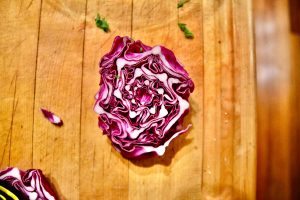 Photo by Natalie Runnerstrom on Unsplash[/caption]
Photo by Natalie Runnerstrom on Unsplash[/caption]
Americans eat over a million pounds of cabbage every year, yet this misunderstood vegetable is one of the most disliked vegetables in the country - 84% of people say that they don’t like cabbage. They clearly haven’t been preparing cabbage in the right way! Cabbage can be dehydrated to make a delicious addition to salads and soups. It can be pickled to make super slaws that make a great side dish for your summer barbecue. You can even freeze the leaves to use later for Japanese pancakes or tasty cabbage rolls. You might have disliked the boiled cabbage you were served up for school dinners, but there are so many different types of cabbage, and it is such a versatile ingredient. The key lies in its preparation.
Dehydrating cabbage
Dehydrating cabbage is one of the best ways to preserve it, and it gives you a stash to use as an ingredient in salads, soups and slaws. Dehydrated cabbage has a great crunchy texture that can elevate your home cooking. Try using different varieties, such as Bok Choy, Savoy Cabbage or Red Cabbage. First you will have to shred your cabbage: a knife is best for this job because it will give you the most control over the size of the pieces. Shredding cabbage yourself will prevent oxidation so that it won’t go brown. Make sure that you use a chef’s knife rather than a smaller knife - ultimately, this is easier to control. Once you have shredded your cabbage, place it in your dehydrator for 8 hours at 125F.
Crispy seaweed
Crispy seaweed, something that you will often get at the Chinese restaurant, is not seaweed at all, but (you’ve guessed it), the humble cabbage. Cavolo Nero or kale are the perfect choice to make crispy seaweed. Remove the middle stalks of the cabbage and cut it into fine strips. Preheat a pan of oil to 350F. Carefully put your cabbage in the oil - it will fizz and crackle. The cabbage only takes a few seconds to cook. You can then sprinkle it with a little salt and sugar if you are eating it immediately. If you’re storing your crispy seaweed, let it cool, and then store it in a Kilner jar.
Fermenting cabbage
Fermenting cabbage is a popular way of preserving it all over the world. From kimchi to sauerkraut, there are so many ways you use your cabbage. All you need to do is chop or slice your cabbage and put it in an airtight container with some brine. The cabbage does need to be fully submerged in the brine, so you may want to use some foil to push it down inside your jar or container. Sauerkraut is the perfect topping for a hotdog, and it is packed with vitamins.
Cabbage is a very underrated vegetable, but it is incredibly versatile. By preserving it, you can have a delicious ingredient on hand to add to your meals, ready-prepared for when you need it.

